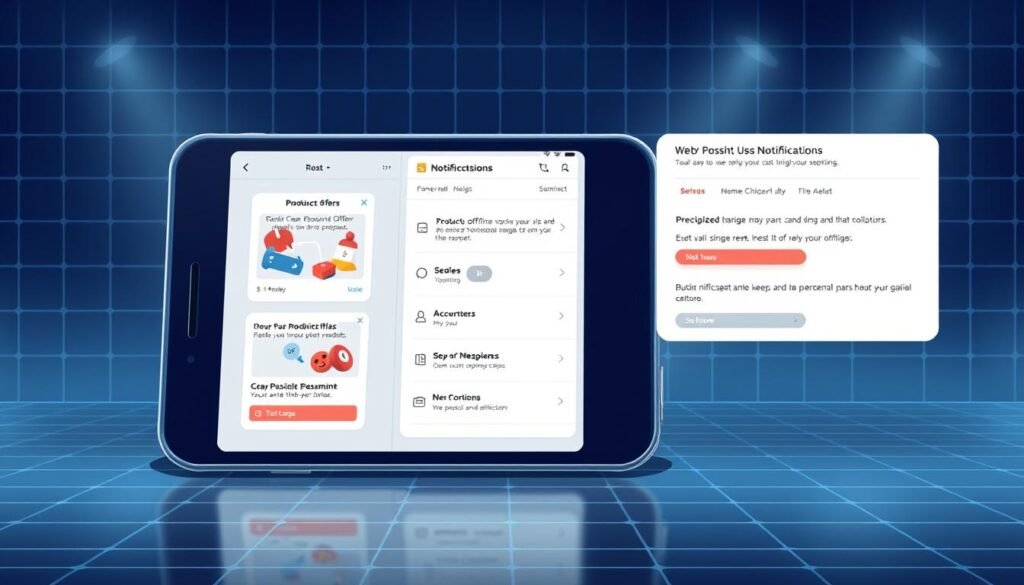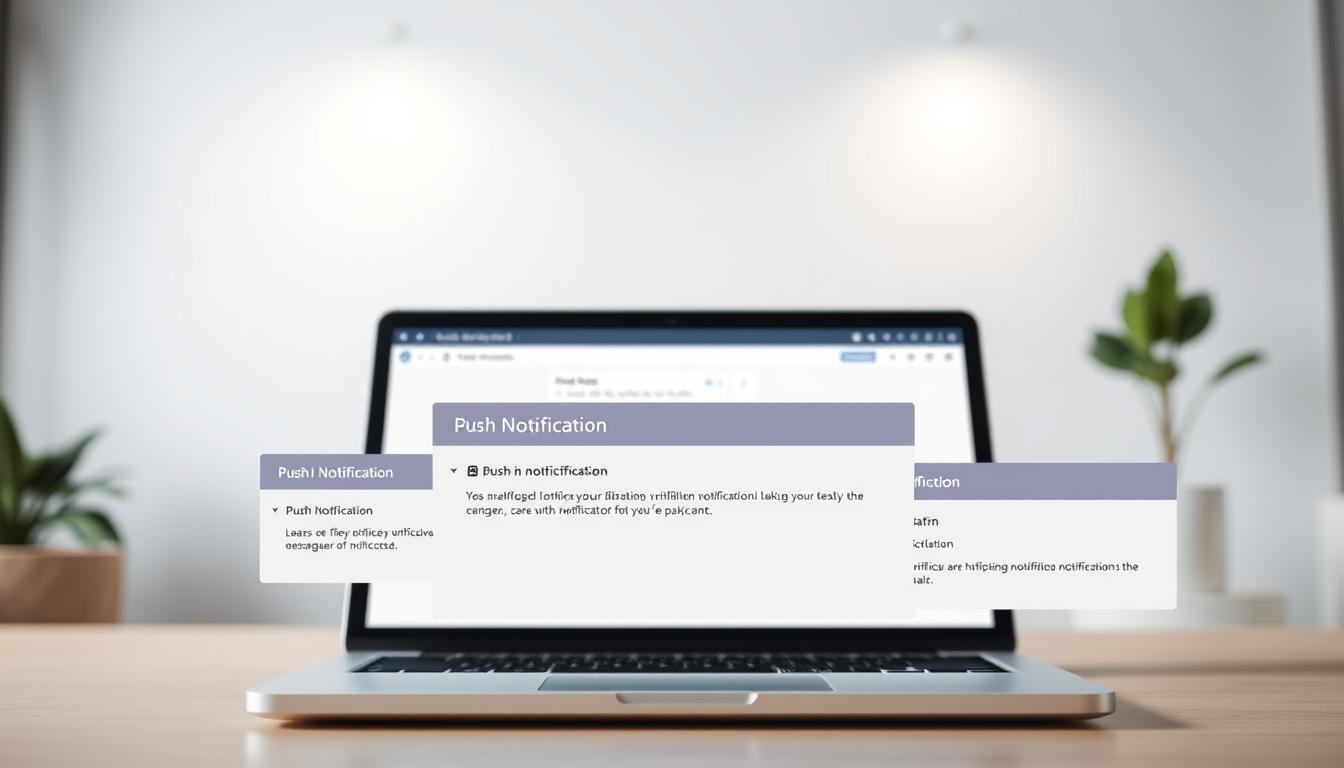This guide shows you how to plan and launch web push notifications that reach visitors even when they are not on your website.
You’ll learn the essentials for a smooth implementation: an account, a correctly defined site (domain or subdomain only), an HTTPS environment, and the required service worker file at the site root.
Consent-first design is central. You request permission through the browser’s native prompt, or use an optional custom prompt first. This approach keeps user privacy top of mind and avoids asking for personal information.
We also cover browser support, the behavior of messages when a visitor is offline, and naming best practices for notifications so you can scale targeting and reporting later.
Follow this guide for a clear, step-by-step way to add timely notifications that boost engagement, bring back subscribers, and fit into your content strategy without heavy reliance on ads.
Key Takeaways
- Implement the getresponse web push setup and consent process exactly once to meet the guide’s scope.
- Require HTTPS and place the service worker at the site root on the same origin.
- Use the browser’s native prompt for permission; respect privacy and avoid collecting personal information.
- Expect varied rendering across browsers and operating systems; test visual content.
- Notifications queue while a browser is closed and deliver when it reopens.
- Name sites and notifications clearly to simplify targeting and measurement.
Why web push matters now: benefits, UX, and when to use it
Modern browser alerts give you a direct line to visitors when they are active online. These instant notifications reach users in real time, often beating email for speed and click-through rate.
Advantages include one-click opt-in without collecting personal information, cross-device reach on desktop and mobile, and higher conversion potential from timely updates.
Messages also queue if a user is offline and deliver once the browser reopens. That resilience keeps campaigns effective without extra work.
Risks remain: excessive frequency can feel intrusive, and short character limits require tight copy. Mitigate these by testing titles, text, images, emojis, and CTA variants.
- Use alerts for product launches, sales, breaking content, or urgent support updates.
- Keep frequency low and timing aligned to audience activity for better retention.
- Segment by device, location, and behavior to raise relevance and conversions.
| Benefit | Risk | Key Metric |
|---|---|---|
| Real-time traffic lift | Subscriber fatigue from too many notifications | CTR and conversion rate |
| One-click opt-in, no form data | Visual rendering varies by browser | Opt-in rate and retention |
| Cross-device reach | Character constraints limit messaging | Engagement per notification |
| Queued delivery when offline | Risk of ad-like perception if poorly targeted | Downstream conversions |
Before you start: prerequisites, compatibility, and secure installation

A short checklist—browser support, HTTPS, and correct worker placement—saves hours of troubleshooting.
Browser and device support considerations
Verify which browsers you will target. Focus on Chrome, Firefox, and other supported engines since appearance and rich media vary by browser and device.
Safari and Internet Explorer 11 are not supported, so plan fallbacks for those users.
HTTPS, tracking code, and service worker placement
Lock down HTTPS on your site; service workers only run in secure contexts. Install an SSL certificate if your website lacks one.
Define the exact site URL (domain or subdomain only). Directories are not allowed when adding a site. This exact url scopes prompts and notifications correctly.
- Install the tracking code in the head of every page where you will request permission and show notifications.
- Download the service worker and place it at the root of the same origin. Do not rename the file.
- Understand that the native browser prompt requests permission; users must allow it before any notification can arrive.
| Prerequisite | Why it matters | Action |
|---|---|---|
| Browser support | Rendering and features differ by engine | Test Chrome, Firefox, Edge; plan fallbacks for Safari/IE |
| HTTPS & origin | Service workers require secure context | Install SSL; confirm root origin matches site url |
| Tracking code & worker | Enables permission flow and identifies contacts | Add code to head; place worker at root, keep filename |
How to perform getresponse web push setup and consent
Start by adding your site in the dashboard. Go to Tools > Push notifications, click Add site, enter a clear name (up to 150 characters) and the exact URL (domain or subdomain only). Optionally upload a default icon so your notifications display consistently.
Create your site and verify the exact URL
Use the exact site url when you add a new entry. Directories are not allowed. This exact match scopes prompts and notifications correctly.
Install the Web Connect code and service worker correctly
Click Get Web Connect to copy the tracking code and paste it into the head of your page templates once. Then download the service worker file and install it in the root directory of the same origin without renaming it.
HTTPS is required to deploy the worker and deliver notifications to visitors and subscribers.
Pick one-click vs two-click opt-in and plan the native prompt
One-click uses only the browser native prompt. Two-click shows a custom prompt first to raise opt-in rates and avoid suppressed native dialogs.
Design custom prompts and map Prompt paths across pages
Create prompts with an internal name, a message up to 128 characters, confirmation and cancellation text, and colors. Preview each variant since appearance varies by browser.
- Use Prompt paths: Entire site, Path starts with, or Path excludes.
- Order rules to prevent overlaps and exclude sensitive pages.
- Monitor prompt views, interactions, and subscriptions to optimize messaging and icon choices.
| Action | Why it matters | Where |
|---|---|---|
| Add site & icon | Brand consistency & exact scope | Tools > Push notifications |
| Install code & worker | Enables permission flow and delivery | Head of page templates & site root |
| Configure prompts | Higher opt-in and targeted reach | Permission prompts & Prompt paths |
Create, target, and deliver web push notifications that convert

Design messages that reach the right visitors at the exact moment they’re ready to act. Start each notification with an internal name, a clear title (≤250 characters), optional text (≤250 characters), and a destination url that lands users on the most relevant page.
Compose titles, text, images, icons, and action buttons
Follow asset rules: images up to 10 MB (recommended 2:1), square icons at least 196×196 px. Add action buttons with labels, URLs, and icons to drive direct actions.
Tip: Use the AI generator to draft title and text, then edit to fit character limits and browser rendering.
Set audience rules, triggers, cooldowns, and topics
Segment by visitors type (all, new, returning), device, and country. Use triggers like delay, scroll depth, exit intent, inactivity, or click events and choose ALL vs ANY logic.
Apply a cooldown to avoid overexposure and assign topics so newer messages replace older unclicked ones while devices are offline.
Preview, test, and pick send now or schedule
Preview on Chrome for macOS, Windows, and Android and test in the browser. Choose Send now for urgent alerts or Schedule with a time zone for planned campaigns.
| Action | Why | Metric |
|---|---|---|
| Preview & test | Ensure legibility across browser/device | CTR, delivery |
| Use topics | Prevent stacking similar notifications | Engagement, retention |
| Segment & triggers | Raise relevance and conversions | Performance vs baseline |
Go beyond broadcasts: automation workflows with Send push notification
Use automation to send timely, contextual notifications that match a visitor’s journey. Automation turns behavior into relevant messages without manual effort. Build flows that react to events, not interrupt them.
Configure site, notification type, unique recipients, and send hours
Important: the Send push notification action must not be the first element in a workflow. Place it after triggers and other steps, and add a Wait (5–10 minutes) after a Subscribe condition to avoid premature prompts.
- Choose the correct site so notifications display only on the intended origin.
- Select the notification type (Sent or Draft copied as an automation message) and pick the exact message to show.
- Enable “Send only to unique recipients” to prevent duplicate exposures and inflated metrics.
- Restrict delivery to a minimum one-hour time window; contacts who enter outside that window wait for the next available period.
- Workflows include only identified subscribers and contacts tracked by the site script; maintain the script for reliable identification and delivery.
- If you import a template from another account, reconfigure action properties because they reset on import.
Workflow best practices: waits, segmentation, and performance timing
Use segmentation upstream by device, visit count, or behavior so notifications feel contextual. Treat timing as a lever: combine Wait blocks, business-hour windows, and behavior triggers to lift conversion performance.
Document each step within the action for team audits. Monitor automation metrics like delivery, clicks, and downstream conversions, then iterate when results lag.
| Setting | Recommended Value | Why it matters |
|---|---|---|
| Placement | Downstream in workflow | Prevents early prompts and respects UX |
| Wait after Subscribe | 5–10 minutes | Avoids immediate, unwanted notifications |
| Delivery window | ≥1 hour | Aligns with audience time and improves performance |
Conclusion
This short roadmap gives you a clear checklist to launch reliable, respectful notifications that move the needle.
Start with technical fundamentals: HTTPS, the exact site origin, the tracking script in your page head, and a root-level service worker. These steps keep delivery and analytics accurate.
Design brief, conversion-focused messages with images, icons, action buttons, and topics to prevent stacking. Use scheduling and behavioral automation to reach the right audience at the right time.
Measure sent, delivered, clicks, and conversions, then iterate. Respect subscriber experience and privacy, test across browser types, and use this guide as a reference as your notification program grows.

